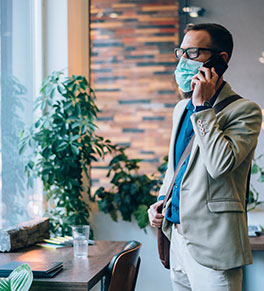Masks: essential in the fight against COVID-19

When everyone wears a mask, we’re all protecting each other, says UCI Health infectious disease expert and epidemiologist Dr. Shruti Gohil.
As the novel coronavirus pandemic marches across America, the Centers for Disease Control & Prevention (CDC) recommends — and the state of California requires — wearing face coverings in public settings to prevent the spread of COVID-19, the disease caused by the virus.
“To get COVID, the virus has to be introduced into your airway, either by breathing it in or through contaminated hands that touch your eyes, nose or mouth,” says Shruti Gohil, MD, MPH, a UCI Health infectious disease specialist and associate director of Epidemiology & Infection Prevention. “The main way this virus seems to be spread is through large droplets.”
Masks, therefore, are an essential tool to block transmission of the virus, she says.
Why wear a mask?
Wearing a face covering prevents virus-infected droplets from spreading when a person with COVID-19 — whether or not they’re experiencing symptoms — coughs, sneezes, sings, talks loudly, or huffs and puffs while exercising.
A mask protects other people from any germs we may spread.
“While there is less information on how well they protect the wearer from others, we have decades of experience using masks in healthcare settings to protect against infections from patients,” Gohil says. “We also require healthcare staffers to wear them for their own protection and we have seen how it prevents them from getting sick.”
When everyone wears a mask, we’re all protecting each other, she says.
“By using a face covering of any type, you’re reducing your risk of exposure,” she explains. “Use any covering you can tolerate — cloth masks, scarves and pull-up gaiters are fine as long as they completely over the nose and mouth.” (Gaiters are cloth tubes worn around the neck that can be pulled up to cover the nose and mouth.)
Nor are masks likely to seriously impede the ability to breathe unless you have a severe respiratory ailment. After all, surgeons and others do just fine wearing even the most protective of masks during hours-long procedures.
What kind of mask is best?
For everyday activities — such as walking outside, shopping in well-ventilated stores or brief encounters with one individual — cloth masks provide sufficient protection. They’re often the most comfortable type to wear, Gohil says. The CDC recommends cloth masks made of tightly woven cotton fabric, but T-shirt material also can be used
At the beginning of the pandemic, there was concern about a critical world shortage of masks called N95 respirators used by healthcare workers. These tight-fitting masks were in great demand because they filter out at least 95% of particles in the air, large and small.
Does the average person need an N95 mask? No, says Gohil.
They are, however, essential for medical professionals who work closely with COVID-19 patients when performing procedures likely to produce tiny aerosolized droplets, such as when inserting a breathing tube, suctioning airways or cardiopulmonary resuscitation (CPR).
But most healthcare workers wear regular surgical masks, even when treating people with COVID-19. Also known as procedure masks, these face coverings are also highly effective at blocking large droplets produced when we cough and sneeze.
“When I see a COVID patient and I’m not doing a procedure, I wear a surgical mask,” she says. “Patients in our hospital are asked to wear cloth or surgical masks, if they can tolerate it.”
Mask etiquette
There’s a right and wrong way to wear — and handle — a mask. Gohil recommends the following mask etiquette:
- Wash your hands or use hand sanitizer before putting on your mask.
- Handle your mask only by the ties or ear holders.
- Avoid touching the front of your mask, which is likely to be the most contaminated area.
- Your mask should cover your face from the bridge of your nose to beneath your chin.
- Immediately wash your hands or use hand sanitizer if you touch your mask while wearing it.
- Don’t pull your mask beneath your chin, push it over your forehead or hang it from one ear.
- Use the ear holders or ties to remove your mask.
- Clean your hands before touching your eyes, nose or mouth.
- Store your mask in a clean plastic bag.
Wash or trash it?
A mask can't protect you or others if it is dirty or contaminated.
“Clean your mask if it gets wet or soiled, or if you haven’t been careful about touching your face without cleaning your hands,” Gohil says.
Cloth masks are especially useful because they are washable.
“The beauty of cloth masks is that you can launder them often,” she says. “If there’s any doubt that it is dirty or contaminated, I just throw it in the washing machine.”
It’s also OK to wash a cloth mask or face covering with other clothes in a washing machine. The CDC recommends using the warmest appropriate setting for both washing and drying.
If you are washing your mask by hand, the CDC recommends soaking it for five minutes in room-temperature water mixed with solution of four teaspoons of household bleach per quart. Rinse well and dry in direct sunlight, if possible.
However, if a mask isn’t washable, it should be thrown away once it is dirty or contaminated.
Make your own face covering
Masks also are easy to make. Follow these CDC instructions. An instruction video in Spanish is also available on YouTube.
Related stories
Explore further
Browse more blog posts by topic.






